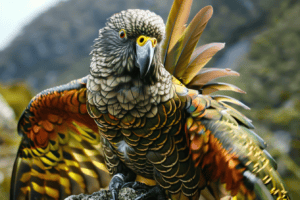Have you ever looked up at the sky to see a little bird soaring almost out of sight, singing as it climbs higher and higher? That’s the skylark.
Known for its powerful and beautiful song, the skylark sings while it flies straight up into the air.
Imagine being able to sing while running up a hill; that’s what makes the skylark’s performance so amazing.
They have a special way of flapping their wings that lets them hover in place while they reach for the clouds with their voices.

The skylark’s song is a burst of notes that seems to bubble out of them like a sparkling fountain.
The magic of this song isn’t just in how it sounds, but in when it happens. They usually start to sing at dawn, just as the world is waking up.
When they sing, they fill the air with music that can be heard over long distances.
This is their way of talking to other skylarks, marking their territory, or trying to impress a mate.
Why do skylarks go to such great heights to sing their song? Is it just for fun, or is there more to this thrilling aerial display?
Scientists think it might help them stay safe from predators while they’re busy singing.
And while many birds sing a song, the skylark’s special mix of high flight and high notes creates a symphony that’s truly a wonder.
Stick with us, and you’ll unravel the mystery of why hearing a skylark’s song can be the highlight of a morning walk.
The Enchanting World of Skylarks
Journey into the world of skylarks where melodious songs fill the air and mystery shrouds their existence, beckoning us to explore their identity and habitats.
Unveiling the Skylark’s Identity
The skylark (Alauda arvensis) is a small bird, easily recognizable by its brown streaked plumage and small crest, often seen springing to life atop its head.
Male skylarks are particularly well-known for their vibrant song during flight.
These captivating birds have a wingspan that typically stretches from 30 to 40 centimeters, allowing them to glide and hover effortlessly through the air.
Have you ever noticed how their wings create a blur of motion against the sky?
That’s the signature dance of the skylark, setting them apart from other birds.
Skylark Habitats: From Farmland to Open Country
Skylarks have made their homes across the fields and open landscapes of Europe.
They prefer open country, thriving in farmlands, moorlands, and grasslands – places where the horizon stretches far and wide.
Picture an endless sea of green where skylarks freely bob and weave!
What’s truly spellbinding is that their nests are not found high in trees but are delicately crafted on the ground, woven amongst the grasses and flowers.
Can you imagine the secret life of these ground-dwelling songsters, camouflaged against prying eyes?
It’s here in these habitats that they rise to the sky, enchanting onlookers with their aerial display and joyful melodies.
A Sky-High Concert: The Song and Flight of Skylarks

Skylarks are known for their spectacular aerial performances coupled with a cascade of song notes.
This section explores both the virtuoso singing and the intricate flight patterns of skylarks.
Melodies in Motion: The Dynamics of the Skylark’s Song
Imagine a small brown bird taking to the sky and as it climbs, bursts into song—a continuous stream of melodious trills and whistles.
This is the male skylark during the breeding season, his vocal prowess on full display.
The skylark’s song is not just a random jumble of notes; it’s carefully structured, varying in tempo and tone to perhaps attract a mate or ward off rivals.
The song can last up to five minutes and is usually delivered at heights of 50 to 100 meters during their song flight.
Imagine being able to keep your tune while running up a hill—quite impressive, isn’t it?
In the Air: Understanding the Skylark’s Aerial Display
The skylark’s aerial display is as captivating as its song.
Picture the male bird as he ascends almost vertically into the air, showing off his flying strength.
It’s like watching an acrobat, expertly moving higher and higher, until he’s just a speck in the sky.
He doesn’t just fly up; he can hover, circle, and even throw in some loops!
With each rise and swoop, his wings work hard, and when it’s time to descend, he doesn’t just plummet.
Instead, he glides down in a spiral, as if on a slide, gently coming back to the earth.
During this whole performance, he’s not just showing off; he’s also marking his territory and displaying fitness to potential mates.
Isn’t it astounding how song and dance—or in this case, flight—are part of nature’s grand show?
Life on the Ground: Family and Food

While the skylark is known for its spectacular song-filled flight, its life on the ground is a busy tapestry of nurturing families and foraging for food.
Romance and Reproduction: The Circle of Life
skylarks are monogamous, often forming pairs for the breeding season.
Nest-building is a joint affair, with both male and female skylarks fervently gathering grasses and stems to craft a cozy cup-shaped nest on the ground, camouflaged among the earthy hues of their habitat.
The female lays a clutch of 3-6 eggs, which she incubates for around 11 days.
After hatching, the chicks remain in the nest for a further 8-10 days before fledging, reliant on their parents for food and protection from predation.
The Skylark’s Quest for Nourishment
These birds forage on the ground for a variety of nourishing seeds and cereals, meticulously combing through fields to find food.
Their diet is a smorgasbord featuring the seeds of knotgrass, fat hen, groundsel, and an assortment of grasses.
Throughout the year, especially in the breeding season spanning February to July, skylarks up their protein intake by hunting insects and invertebrates like beetles and spiders, essential for the growth of their young.
These birds follow a diurnal pattern, which means all their busyness takes place during daylight hours.
Skulk through the underbrush, and you might spot these brown-backed birds with short tails and a length of typically 18-19 centimeters, diligently pecking at the ground searching for their next meal.
Conservation and Culinary: Human Connections

The interplay between skylarks, agricultural practices, and human appreciation is intricate, touching upon both the unity and challenges in conserving these birds amid evolving landscapes.
Shared Spaces: Skylarks and Agriculture
Skylarks make their homes in the expansive fields of farmland that sprawl across many regions, from the marshes and meadows of New Zealand to Asia’s agriculture-heavy landscapes.
The birds favor open grassland where they can easily spot potential threats.
This preference often aligns with areas of human agriculture—a space shared but not always peacefully.
By August, when crops are tallest, skylarks may struggle to find suitable nesting sites, leading some farmers to create ‘skylark plots’—specific sections of land left unsown to offer safe nesting spaces within the farmland mosaic.
Protection and Appreciation: Humans and Skylarks
Human fascination with skylarks is captured in literature and music, stemming from the bird’s enchanting vertical flight and melodic song.
In the British population, found across the grasslands of London and widespread across the UK, efforts by organizations such as the RSPB aim to protect these birds.
They guide farmers in adopting wildlife-friendly agricultural practices to ensure skylarks have room to thrive.
Both female and male skylarks take to the skies, although males are particularly vocal during their impressive aeronautical displays.
Did you know their colors range from grey to a lovely yellow, making them both a delight to hear and a challenge to identify amid the golden hues of farmland?
With careful management and public support, we can hope the population of these songbirds remains free to rise and fall, echoing across shared skies.
Frequently Asked Questions

Exploring the enchanting world of Skylarks, a symphony of questions often arises.
Their unique habits capture the imagination, and here we answer some of the most intriguing inquiries about these melodious birds.
What times of the year can we hear the Skylarks’ enchanting melodies?
The Skylarks serenade the skies predominantly during the spring and early summer, as this is their breeding season.
It’s during this time their songs fill the air, often starting just before dawn, peaking as the sun climbs, and then tapering off as the day progresses.
When observing Skylarks, are we likely to witness their vocal performances mid-flight or while they’re perched on the ground?
These birds are famed for their aerial performances, often singing a bubbling cascade of notes while in flight.
A Skylark’s song is usually heard as it climbs vertically into the sky and then parachutes back to the ground, making it a fascinating display of aeronautical and vocal prowess.
What inspires a Skylark to begin its overhead symphony?
When a Skylark takes off into its vertical ascent, it is often driven by the urge to mark its territory, attract a mate, or ward off intruders.
The bird’s complex and lengthy song acts as a signal to other Skylarks and showcases the health and vitality of the singer.
How does the Skylark’s aerial serenade differ from the songs of other birds?
Skylarks are unique in that they can sing for up to three minutes straight while hovering high in the sky, a feat that sets them apart from most other songbirds.
Their song is not only long but also incredibly varied, with a repertoire of over 300 distinct syllables.
Can the weather influence when and how the Skylarks perform their airborne concerts?
Indeed, weather plays a role in the Skylarks’ performances. They prefer to sing in sunny, calm conditions.
Strong winds or rainy weather might deter their activities. On a clear day, their trills and warbles are more likely to grace the skies.
In what ways have the Skylarks’ vertical flights and songs impacted human arts and culture?
The SkyLarks’ soaring songs have influenced human culture deeply, inspiring poems, songs, and stories.
Artists and writers have often captured the essence of the Skylark’s flight and its connection to the themes of freedom and aspiration.
One famous example is Percy Bysshe Shelley’s poem “To a Skylark,” where he admires the bird’s effortless connection to the beauty of the natural world.









